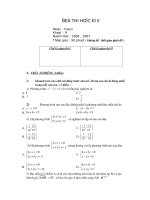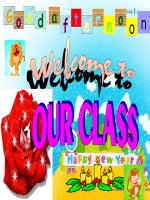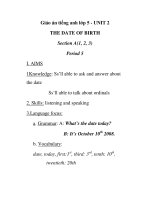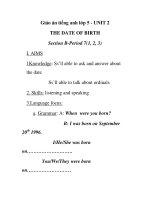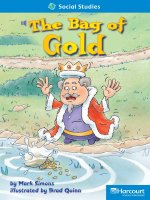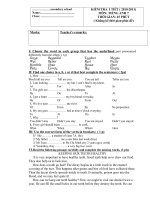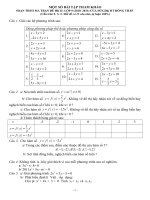- Trang chủ >>
- Mầm non - Tiểu học >>
- Lớp 5
5 3 2 the inspiration of art (social studies) TG
Bạn đang xem bản rút gọn của tài liệu. Xem và tải ngay bản đầy đủ của tài liệu tại đây (105.08 KB, 4 trang )
The Inspiration of Art
SUMMARY
Many modern artists are influenced
by techniques and styles of famous artists
of the past. They use these techniques, as
well as their own styles, in their art. These
combined styles make completely new styles
of art.
LESSON VOCABULARY
baroque
cubism
incorporated
intricate
sinuous
cast
facade
innovative
razing
INTRODUCE THE BOOK
INTRODUCE THE TITLE AND AUTHOR
Discuss
with students the title and the author of
The Inspiration of Art. Based on the title, ask
students what kind of information they think
this book will provide. Have students look at
the cover illustration and tell how it relates
to the book’s title.
BUILD BACKGROUND
Discuss with students
what they know about different artists or
types of art, such as paintings or sculptures.
Have students share their thoughts with the
class. Encourage them to name specific
artists or works of art.
Encourage students to describe what
they know about art and artists from their
cultural backgrounds.
PREVIEW/USE TEXT FEATURES
As students
preview the book, ask them to look at the
illustrations and read the captions. Draw
their attention to the various types of art and
architecture shown. As a class, summarize
what students think the book will teach them.
56
5.3.2
MAIN IDEA AND DETAILS
SUMMARIZE
READ THE BOOK
SET PURPOSE
Have students set a purpose
for reading The Inspiration of Art. Encourage
them to think about the important facts
in the selection as they read. Ask them to
pay attention to the different types of art
described, using the illustrations to enhance
their understanding.
STRATEGY SUPPORT: SUMMARIZE As students
read, summarizing helps them understand the
important parts of the book. Have students
write short summaries of each section based
on their understanding of the section’s main
idea. Remind them that details do not belong
in a summary.
COMPREHENSION QUESTIONS
PAGE 5
What is the main idea of the last
paragraph under “The Story of Laocoön”?
(The emperor Titus kept the sculpture Laocoön
on display in Rome until his death, after which
it disappeared.)
PAGE 14
What was Rodin’s most famous
sculpture? (The Thinker)
PAGE 20
Summarize the first paragraph. (The
best modern painters combine earlier art styles
with their own styles to create new types of
art.)
PAGE 20
What conclusions can you draw
about Pablo Picasso’s cubism? (Picasso also
borrowed from artistic styles of the past to
create his cubist works.)
The Inspiration of Art
16924_LRD_TG_056-057 56
1/4/06 9:41:39 AM
REVISIT THE BOOK
READER RESPONSE
1. Main idea: The San Carlo was revolutionary
in its design. Supporting details: Instead of
being flat, its facade had curves. Its design
created the effect of constant motion. It
influenced Frank Gehry’s design for the
Guggenheim Museum in Manhattan.
2. Possible response: Michelangelo was
present in 1506 when the Laocoön was
rediscovered. He drew it and studied it
and tried to use its ancient sculptural
techniques in his own work.
3. Possible response: inspiration: influence of
thought and feelings on actions; involved:
included; incredible: hard to believe;
individual: single or particular; invent:
to make something for the first time.
Sentences will vary but should demonstrate
students’ understanding of the words.
4. Answers will vary but should include
specifics as to style, subject matter, or
details.
EXTEND UNDERSTANDING
Ask students to look
at the illustrations in the book. Ask them how
the pictures help them better understand the
descriptions of the art in the book.
RESPONSE OPTIONS
WRITING
Have students choose one of the
illustrations from the book and write a
description of the artwork. Encourage them
to write about the colors, textures, and the
feelings the artwork evokes.
ART CONNECTION
Skill Work
TEACH/REVIEW VOCABULARY
Review vocabulary words and their
definitions with students. Have volunteers
point to illustrations in the book that show
or help explain as many vocabulary words
as possible.
TARGET SKILL AND STRATEGY
MAIN IDEA AND DETAILS Remind students
that the main idea is the most important
idea about a topic. As they read, have
students write a short sentence that tells
the main idea of each section. Have them
include a few supporting details for each
main idea.
SUMMARIZE Remind students that to
summarize is to boil down to its most
important elements what is said in a
passage. Explain that when you summarize,
you tell only the most important ideas,
leaving out the details. Have students write
summaries of each section, using the main
ideas they wrote for each section.
ADDITIONAL SKILL INSTRUCTION
DRAW CONCLUSIONS
Remind students that
drawing conclusions is arriving at opinions
that make sense after thinking about facts
and details. As students read, encourage
them to list important facts in the book and
think about what conclusions they can draw
from these facts. Have them write out their
conclusions.
Encourage students to look at other works of
art by the artists in the book. Have them find
books in the library or Internet photos. Have
them share favorite works of art.
The Inspiration of Art
16924_LRD_TG_056-057 57
57
1/18/06 10:51:24 AM
The Inspiration of Art
Name
Main Idea and Details
• The main idea is the most important idea about a paragraph, passage, or article.
• Supporting details are small pieces of information that tell more about the main idea.
Directions Read the paragraph below. Then complete the graphic organizer by writing the
main idea of that passage. List details that tell more about the main idea.
M
ichelangelo was not the first artist to borrow designs from work done in the past. Artists
have always studied the art of earlier times. Often they have copied individual figures
to use in their own works of art. In Michelangelo’s time, this kind of copying was considered
a compliment. It showed respect and admiration for older artists and contributed to the
preservation of important themes from past artistic styles.
1. Main Idea
Supporting Details
3.
4.
© Pearson Education 5
2.
58
16924_LRD_TG_058_059 1
1/4/06 9:42:00 AM
The Inspiration of Art
Name
Vocabulary
Directions Write the word from the box that best completes each sentence.
Check the Words You Know
baroque
facade
intricate
cast
incorporated
razing
1. Rodin
2–3.
cubism
innovative
sinuous
small figures from his doors into other sculptures.
architecture uses curved, often
lines.
4. Rodin modeled in clay, and then he
the clay form in bronze.
details on the building’s
5–6. The fine,
stood out in sharp contrast when the sun shone directly on them.
7. Picasso’s style called
geometric shapes.
8–9. Creating new and
breaks down images into simple
architecture sometimes requires
, or destroying, older buildings that are in the way.
© Pearson Education 5
Directions Imagine you were alive during the Renaissance and that Michelangelo was your friend.
Write a paragraph about visiting him, using as many vocabulary words as you can.
59
16924_LRD_TG_058_059 2
3/20/06 8:46:30 AM
